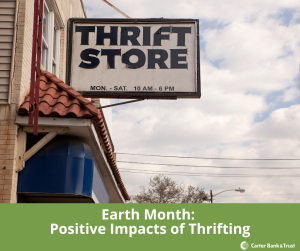As we celebrate Earth Month, we can all take small but meaningful steps towards a greener future. One way to do so is by embracing thrift shopping and second-hand buying. Not only does it allow you to save money, but it also has a positive impact on the environment. In this blog post, we’ll explore the various benefits of thrifting, including the reduction of waste, conservation of resources, and mitigation of environmental impact.

Reduction of Waste
Thrifting prevents millions of pounds of waste from filling landfills, making it an eco-friendly choice. One of the well-known organizations that engage in thrifting is Goodwill Industries. Their number one priority is to resell donated items. Items that cannot be resold are either recycled or repurposed. For example, clothing and electronics are recycled sustainably at Goodwill Industries. By participating in these activities, they create jobs and programs for individuals in the communities. Goodwill Industries’ practice of the 4Rs of sustainability – reduce, reuse, repurpose, and recycle – has reported significant impact in 2022-2023.
Conservation of Resources
Thrifting also helps conserve resources. It prolongs the life of products, preventing the need for new manufacturing, and reducing the consumption of raw materials, energy, and water required for production. When you give pre-loved items a new home, you participate in a cycle of resource conservation that benefits both the environment and future generations.
Mitigation of Environmental Impact
The production and transportation of new goods generate substantial carbon emissions. Thrift shopping significantly reduces the carbon footprint associated with manufacturing and shipping. It also minimizes greenhouse gas emissions linked to the production and transportation of new products. A small shift in your shopping habits can lead to a notable reduction in your personal carbon footprint.
Saving Valuable Resources – Save Money
Thrifting is a budget-friendly alternative. Depending on the product and frequency of purchases, people save 25% to 50% off the original price of items. Coupon Follow reported that thrift store shoppers save nearly $1,800 each year by shopping secondhand, and that 62% of Gen-Z and millennials prefer shopping secondhand over buying new. Thrifting could potentially help meet some personal financial goals, such as vacations, purchasing birthday presents, opening a Christmas club, or saving to purchase a big-ticket item rather than using credit as a resource.
Thrifting to a Greener Future
By embracing thrift shopping, we’re supporting local economies, strengthening community bonds, promoting ethical consumption, reducing demand for new goods, and investing in quality timeless finds with character. It’s also an opportunity to express personal creativity and style. Furthermore, by shopping with a purpose, we can support non-profit causes and make a positive impact on the world.
In conclusion, thrifting is not only an eco-friendly choice, but it’s also a budget-friendly and socially responsible alternative. By taking small steps towards a greener future, we can contribute to a safer and healthier planet for ourselves and future generations. So, let’s embrace thrift shopping this Earth Month and beyond!
